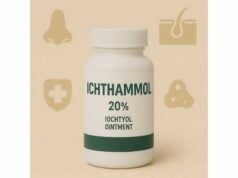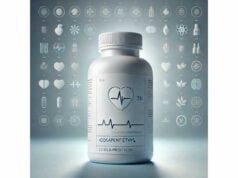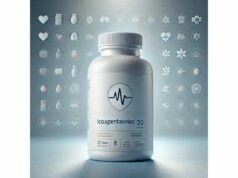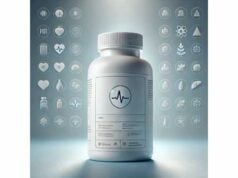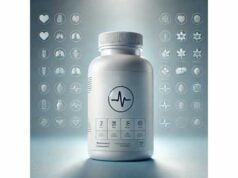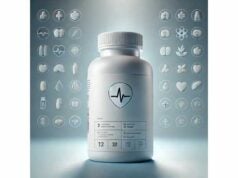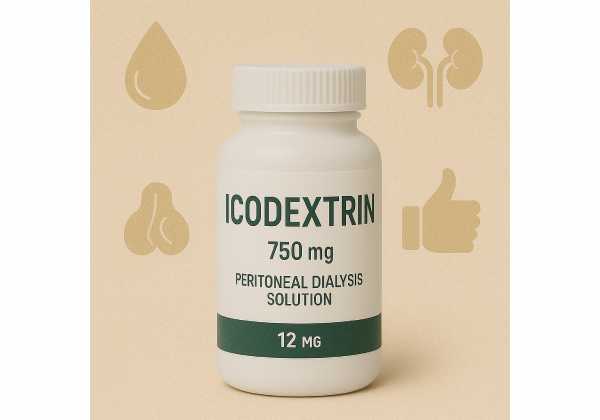
Icodextrin is a starch-derived glucose polymer used as an osmotic agent in peritoneal dialysis and, in a different formulation, as a temporary intraperitoneal instillate to reduce postoperative adhesions. In dialysis, it supports sustained ultrafiltration during long dwells, helping manage fluid overload, support blood pressure control, and reduce exposure to high-glucose dialysate. Compared with conventional dextrose solutions, it provides steadier water removal over 8–16 hours and less carbohydrate absorption. Its benefits are clearest in people with high or high-average peritoneal transport, frequent fluid overload, or diabetic patients who need to limit glucose exposure. Icodextrin is generally well tolerated, but it has specific safety rules—especially around blood glucose monitoring devices that can misread maltose metabolites. Used correctly within a personalized prescription, icodextrin can improve day-to-day comfort, fluid balance, and technique longevity for many people on peritoneal dialysis.
Key Insights
- Sustains long-dwell ultrafiltration (8–16 hours) with less absorbed glucose than 4.25% dextrose.
- May aid fluid status and cardiovascular surrogates (e.g., left ventricular mass) in selected patients.
- Typical dialysis dose: one 2.0–2.5 L exchange of 7.5% icodextrin once daily for the long dwell (8–16 h).
- Use only glucose-specific meters or CGM; GDH-PQQ/GDO methods can read icodextrin metabolites as glucose.
- Avoid in glycogen storage disease, maltose/isomaltose intolerance, severe lactic acidosis, or known hypersensitivity.
Table of Contents
- What is icodextrin and how it works
- Benefits for peritoneal dialysis
- How to use icodextrin in PD
- Dosage and timing guidance
- Side effects and safety
- Evidence at a glance
What is icodextrin and how it works
Icodextrin is a water-soluble polymer produced from cornstarch with predominantly α-1,4 glycosidic bonds and a minority of α-1,6 linkages. In peritoneal dialysis (PD), a 7.5% icodextrin solution is used as an osmotic agent to remove excess water (ultrafiltration) through the peritoneum. Mechanistically, icodextrin acts as a colloid osmotic agent: its relatively large molecular size exerts sustained oncotic pressure across small intercellular pores in the peritoneal capillary wall. Rather than drawing fluid quickly and then dissipating (as hypertonic glucose solutions tend to do), icodextrin maintains more linear fluid removal across long dwell periods. For patients, this translates into steadier overnight or daytime fluid control and less “rebound” reabsorption at the end of a dwell.
Absorption is mainly lymphatic and proceeds at a roughly constant rate. During a 12-hour dwell, a substantial fraction of the instilled dose may be absorbed. In the systemic circulation, icodextrin is metabolized by α-amylase into maltose and other oligosaccharides, which are cleared by the kidneys. Because these metabolites are sugars, they can interfere with some older blood glucose tests that are not glucose-specific. That is why device compatibility is a core safety point for anyone using icodextrin and insulin.
Clinically, icodextrin is indicated to support long-dwell ultrafiltration in both continuous ambulatory peritoneal dialysis (CAPD) and automated peritoneal dialysis (APD). It is particularly useful in people with high or high-average peritoneal transport where glucose-based long dwells underperform, and in those who need to limit glucose burden (e.g., patients with diabetes, obesity, or problematic hyperglycemia from conventional dextrose dialysate). Because the solution is near-isosmolar and uses a polymer rather than free glucose, it can reduce the absorbed carbohydrate load over time versus repeated use of hypertonic glucose.
Outside dialysis, a distinct 4% icodextrin solution is used as an intraoperative irrigant and postoperative instillate to help reduce abdominopelvic adhesions, primarily in gynecological laparoscopic adhesiolysis. The anti-adhesion effect is physical: the solution temporarily maintains a fluid reservoir that separates peritoneal surfaces during the early postoperative healing window.
In summary, icodextrin’s value comes from steady long-dwell ultrafiltration, reduced exposure to high-glucose dialysate, and utility in specific patient profiles where glucose-based solutions are inadequate or metabolically undesirable.
Benefits for peritoneal dialysis
Steadier long-dwell ultrafiltration. The most consistent clinical advantage of icodextrin is more predictable fluid removal across long dwells (typically 8–16 hours). Where 1.5%–4.25% dextrose solutions may show early brisk ultrafiltration followed by net reabsorption near the end of the dwell—especially in high transporters—icodextrin’s colloid effect continues to draw water throughout, often yielding higher net ultrafiltration at the finish. Patients who retain fluid overnight or wake up with edema despite hypertonic glucose commonly see improvement when the long dwell is switched to icodextrin.
Less carbohydrate absorption per unit ultrafiltration. Because icodextrin is a large polymer, the amount of absorbable carbohydrate per liter of dialysate is lower than with hypertonic glucose. For individuals with diabetes or those concerned about weight and triglycerides, replacing a daily 4.25% dextrose long dwell with icodextrin can modestly reduce the glycemic and caloric footprint of therapy. While icodextrin is not a weight-loss strategy, its use can be part of a broader plan to limit glucose exposure from the PD regimen.
Support for blood pressure and edema control. Better long-dwell ultrafiltration often improves extracellular volume status. Clinicians frequently report fewer episodes of uncontrolled fluid overload, better ankle edema, and sometimes smoother antihypertensive requirements when icodextrin is integrated appropriately. In select patients—particularly those with persistent hypervolemia on APD—adding icodextrin for the daytime dwell can reduce interdialytic weight fluctuation and dyspnea.
Potential cardiovascular surrogate improvements. In small randomized studies, enhanced fluid control with icodextrin has corresponded to favorable movement in cardiovascular surrogates (e.g., left ventricular mass index). These signals are most relevant in patients with recurrent fluid overload, where steady volume control is central to symptom relief and cardiac risk modification. While long-term hard outcomes remain an area of study, the day-to-day gains in comfort and volume status are clinically meaningful.
Technique survival and peritoneal-membrane strategy. For high or high-average transporters who struggle with long dwells, prescribing icodextrin can help maintain adequate ultrafiltration without relying exclusively on frequent hypertonic glucose exchanges. This can be part of a membrane-sparing strategy to reduce glucose degradation product exposure, potentially supporting longer technique survival when combined with sound infection prevention and training.
Metabolic profile compared with glucose. Icodextrin does not eliminate metabolic concerns. It can still affect sodium balance and, through its metabolites, interact with certain glucose meters. But when the goal is to minimize cumulative glucose absorption from PD, substituting icodextrin for the single longest daily dwell is one of the most effective levers available.
When it helps most. Typical scenarios where icodextrin shines include: high transporters with low net ultrafiltration on long glucose dwells; APD patients with fluid overload after nocturnal cycles; patients with diabetes requiring tight glucose exposure control; and individuals with edema or hypertension despite careful PD training and adherence.
How to use icodextrin in PD
Select the right dwell. Icodextrin is designed for a single long dwell per day—either the daytime dwell in APD or the overnight dwell in CAPD. The prescription choice depends on the patient’s daily routine and where sustained ultrafiltration is needed most:
- APD users: Commonly instilled at the end of the night cycle to remain in the abdomen during daytime (e.g., 12–15 hours).
- CAPD users: Often used for the overnight dwell after the final evening exchange (e.g., 8–12 hours).
Match to transport type and symptoms. High and high-average transporters tend to gain the most ultrafiltration benefit on long dwells. If a patient is experiencing morning edema, weight gain between cycles, or poor net UF on hypertonic glucose, consider switching the problematic long dwell to icodextrin.
Integrate with the rest of the regimen. Icodextrin is not a replacement for all exchanges. Most prescriptions maintain glucose-based solutions for shorter dwells or machine cycles and use icodextrin for the single longest dwell. This approach balances UF performance with operational simplicity and cost.
Coordinate with diabetes care. Before the first icodextrin exchange, verify glucose-monitor compatibility. Only glucose-specific technologies should be used for fingerstick checks. Certain test systems (e.g., GDH-PQQ, GDO, and some GDH-FAD) can misread icodextrin metabolites (maltose, etc.) as glucose, falsely elevating results. Continuous glucose monitoring (CGM) systems vary in compatibility; when in doubt, confirm with the device manufacturer and the nephrology/diabetes team. Educate the patient and caregivers about this interaction and what devices/strips to avoid.
Teach monitoring and expectations. Patients should know how to recognize adequate vs. inadequate UF (e.g., tracking drain volumes, weight trends, edema). Because icodextrin maintains UF later into the dwell, some people notice gentler fill–drain transitions. Reinforce aseptic technique and routine inspection of effluent for cloudiness or fibrin.
When to consider the adhesion-reduction formulation (surgical use). The 4% icodextrin adhesion-reduction solution is used only intraoperatively and postoperatively by surgeons, not by dialysis patients at home. It is instilled in the peritoneal cavity at the end of indicated gynecological laparoscopic adhesiolysis (typically around 1 L as a residual instillate), with additional volumes used for periodic irrigation during the case, according to labeling. This formulation is distinct from the 7.5% PD solution and is not used for dialysis.
Checklist before starting:
- Confirm indication: long-dwell UF need, glucose-load reduction, or both.
- Review contraindications (hypersensitivity, maltose/isomaltose intolerance, glycogen storage disease, severe lactic acidosis risks).
- Verify blood glucose monitoring device compatibility.
- Set expectations for dwell time (8–16 h), exchange volume (usually 2.0–2.5 L), and where it fits in the daily schedule.
- Plan early follow-up (1–2 weeks) to review UF volumes, weight, edema, and any rash or GI symptoms.
Dosage and timing guidance
Peritoneal dialysis (7.5% icodextrin).
- Who administers: The patient or caregiver as part of a home PD routine under clinical supervision.
- Exchange volume: Commonly 2.0–2.5 L once daily, adjusted to patient size, intra-abdominal pressure, and comfort.
- Dwell time: Typically 8–16 hours for the single longest dwell (overnight for CAPD; daytime for APD).
- Infusion time: Usually 10–20 minutes, adjusted for comfort and catheter function.
- Potassium: The solution contains no potassium; clinicians may add potassium chloride (up to ~4 mEq/L) when needed to prevent hypokalemia.
- Monitoring: Daily weights, UF volumes, blood pressure, edema. Electrolytes, acid–base status, nutritional markers, and HbA1c/CGM metrics as clinically indicated.
Practical tips to optimize UF:
- Keep icodextrin for the single longest dwell; do not split into multiple long dwells unless a specialist explicitly prescribes this (most regimens use one icodextrin exchange per 24 hours).
- If UF remains low, review transport status, catheter function, and dwell duration before changing concentration or volume.
- In high transporters on APD, a daytime icodextrin dwell after nocturnal cycles often improves fluid balance without a nightly hypertonic glucose burden.
- Avoid unnecessary hypertonic glucose exchanges once icodextrin is added; this helps curb cumulative glucose exposure.
Who benefits metabolically:
- Patients whose glucose control worsens with repeated hypertonic dextrose.
- Individuals targeting weight stabilization while maintaining adequate UF.
- Those with edema/hypertension that spikes after long glucose dwells.
Surgical adhesion-reduction solution (4% icodextrin).
- Setting: Operating room and immediate postoperative period.
- Use pattern: Employed as an irrigant during the case and ~1 L is commonly left in the peritoneal cavity at closure in indicated gynecologic laparoscopic adhesiolysis, per product labeling.
- Goal: Temporary separation (“hydroflotation”) of peritoneal surfaces for several days, during the critical healing window when adhesions form.
- Not interchangeable with the PD solution: different indication, users, and perioperative safety considerations.
When to reassess the prescription:
- Persistent edema or weight gain despite adherence.
- Abdominal discomfort suggesting overfill or high intra-abdominal pressure.
- Unexplained rashes, pruritus, or signs of hypersensitivity.
- Repeated cloudy effluent or peritoneal symptoms (evaluate for peritonitis).
- Changes in diabetic therapy or glucose-monitoring technology.
What not to do:
- Do not use non-glucose-specific fingerstick meters or incompatible CGM systems while on icodextrin.
- Do not infuse intravenously or intra-arterially (PD solution is for intraperitoneal use only).
- Do not exceed prescribed volumes or leave multiple icodextrin exchanges in situ unless directed by a specialist.
Side effects and safety
Common and expected effects. Many patients tolerate icodextrin well. Mild GI symptoms (e.g., fullness) can occur. Because the solution is near-isosmolar and used for long dwells, some people perceive gentler fluid shifts than with hypertonic glucose. Routine PD risks—electrolyte shifts, protein loss, and volume misestimation—still apply and warrant periodic labs and clinical review.
Hypersensitivity and skin reactions. Hypersensitivity reactions ranging from rash and pruritus to rare severe reactions (e.g., toxic epidermal necrolysis, angioedema) have been reported. Any systemic rash, mucosal involvement, or signs of anaphylaxis warrant immediate discontinuation and urgent medical evaluation. Patients with known hypersensitivity to icodextrin or cornstarch-derived polymers must avoid it.
Peritonitis and EPS vigilance. Infectious and aseptic peritonitis can occur with any PD solution. Aseptic technique remains critical. Cloudy effluent, abdominal pain, fever, or fibrin strands merit urgent assessment. Encapsulating peritoneal sclerosis (EPS) is a rare, serious complication associated with long-term PD; clinicians monitor for unexplained inflammation, obstruction symptoms, or malnutrition over time. Use of icodextrin does not eliminate these risks.
Electrolyte and volume balance. Because icodextrin sustains UF, unrecognized volume depletion can occur if the prescription overshoots the patient’s needs. Conversely, inadequate UF may persist if dwell times are too short or catheter function is impaired. Regularly reconcile prescribed UF with daily weights, edema, and blood pressure.
Critical diabetes device interaction. Icodextrin metabolites (notably maltose) can cause falsely elevated readings with certain blood glucose test methods—classically GDH-PQQ and GDO, and some GDH-FAD systems. These false highs have led to inappropriate insulin dosing and unrecognized hypoglycemia. Patients must use glucose-specific meters/strips and confirm CGM compatibility; when changing devices, re-check compatibility with the manufacturer and care team. The interference can persist up to two weeks after stopping icodextrin.
Contraindications and cautions.
- Do not use in individuals with known hypersensitivity to icodextrin; maltose or isomaltose intolerance; glycogen storage disease; or severe lactic acidosis risks where the lactate buffer may worsen acidosis.
- Use with caution in patients with severe hypotension or sepsis, and in those at risk of lactic acidosis from medications or inborn errors of metabolism.
- Surgical 4% solution is contraindicated with frank intra-abdominal infection, use during laparotomy, or procedures involving bowel resection/repair or appendectomy, given reported wound and anastomotic complications in those settings.
When to seek help immediately.
- Signs of hypersensitivity (swelling of face or tongue, hives, breathing difficulty).
- Severe abdominal pain, rigid abdomen, or persistent cloudy effluent.
- Symptoms of hypoglycemia with unexpectedly high fingerstick readings (possible meter interference).
- Rapid weight change, severe edema, or shortness of breath.
With deliberate device selection, appropriate dwell timing, and regular follow-up, most patients can use icodextrin safely and benefit from steadier fluid control.
Evidence at a glance
Mechanism and labeling. The peritoneal dialysis icodextrin solution (7.5%) is indicated for long-dwell ultrafiltration in CAPD and APD. Labeling describes its composition, pharmacology, dosing (single daily exchange for the long dwell), and key warnings, including the glucose-meter interaction caused by maltose metabolites. These documents also outline contraindications such as hypersensitivity to icodextrin, maltose/isomaltose intolerance, glycogen storage disease, and severe lactic acidosis risk.
Guideline context. International peritoneal dialysis guidance emphasizes tailoring prescriptions to membrane characteristics and clinical goals. For people with high or high-average peritoneal transport or with persistent fluid overload, using icodextrin for the long dwell is a recommended strategy to improve net ultrafiltration and fluid status. Contemporary peritonitis guidance reinforces aseptic practice, monitoring, and program-level quality metrics while acknowledging solution choice as part of a broader PD care plan.
Clinical outcomes. Randomized data show that, versus long glucose dwells, icodextrin can provide superior long-dwell ultrafiltration. In small RCTs and prospective analyses, better volume control with icodextrin has been associated with improvements in cardiovascular surrogates such as left ventricular mass index in selected patients, though larger and longer studies are needed to confirm effects on hard outcomes.
Surgical use. The 4% icodextrin adhesion-reduction solution is FDA-approved as an adjunct to good surgical technique for reducing adhesions in indicated gynecological laparoscopic adhesiolysis. Trials and device summaries describe its mechanism (temporary hydroflotation), typical intraoperative irrigation plus ~1 L instillate at closure, and specific contraindications and warnings that differ from the PD indication.
Bottom line. For the right patient, icodextrin meaningfully strengthens a PD prescription by delivering sustained long-dwell UF with a lower absorbed glucose burden. Its safe use hinges on correct device selection for glucose monitoring, appropriate patient selection, and routine PD vigilance.
References
- DailyMed – EXTRANEAL- icodextrin, sodium chloride, sodium lactate, calcium chloride, magnesium chloride injection, solution 2025 (Labeling/Mechanism/Dosing/Safety).
- ISPD peritonitis guideline recommendations: 2022 update on prevention and treatment – PubMed 2022 (Guideline).
- ISPD recommendations for the evaluation of peritoneal membrane dysfunction in adults: Classification, measurement, interpretation and rationale for intervention – PubMed 2021 (Guideline).
- A randomized clinical trial to evaluate the effects of icodextrin on left ventricular mass index in peritoneal dialysis – PubMed 2022 (RCT).
- ADEPT® (4% ICODEXTRIN) ADHESION REDUCTION SOLUTION INFORMATION FOR PRESCRIBERS 2006 (Device Labeling/Indication/Contraindications).
Medical Disclaimer
This article is for general information and education only. It does not replace personalized medical advice, diagnosis, or treatment. Decisions about peritoneal dialysis prescriptions, icodextrin use, glucose-monitor compatibility, and surgical products must be made with a qualified healthcare professional who knows your health history. If you think you are experiencing a medical emergency or a serious side effect, call your local emergency number or seek urgent care immediately.
If you found this guide helpful, please consider sharing it on Facebook, X (formerly Twitter), or your preferred platform, and follow us for future updates. Your support helps us continue producing high-quality, people-first health content.

